A great chef once told me that people eat with their eyes first; they’ve already judged their meal by its appearance before taking their first bite. Over the past 10 years working as a commercial photographer, I find the same is true with wine photography. Quality photography is a key component of any successful marketing campaign. Not only do your images need to look professional and consistent with the brand’s style, they also need to tell a story that keeps your consumers engaged. Below, I’ll share several insights and practices that I’ve developed that are essential for any successful project.
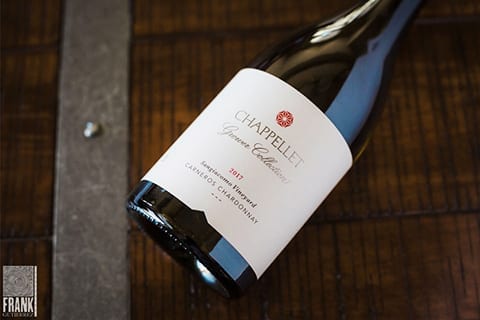 1. Bottle Photography
1. Bottle Photography
A compelling bottle shot is key to attracting your customers attention. Think about all the places your bottle shots appear – websites, fact sheets, case cards, and magazine publications like Wine Spectator or Food & Wine. I always adhere to the following tips to help present the wine in the best possible light. First, identify your BEST bottle — your subject should have the best looking label and capsule with no scratches, air bubbles, and be mounted perfectly straight. Second, wipe off any dust or lint on the bottle and make sure the glass seam lines run around the label and not underneath it. If you’re photographing a white wine, remove the back label because it will improve the overall brightness of the wine. Lighting is key to a great-looking bottle shot, and I recommend taking advantage of the natural light that’s available. When you’re ready to shoot, bring your bottle closer to a window. Place a white foam board on the opposite side of the bottle to reflect this light and fill in the shadows on your label. This creates a sleek looking reflection on the glass and really makes the label pop.
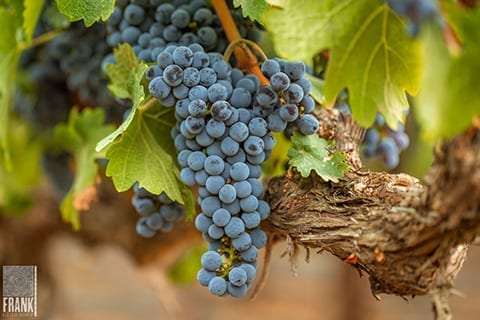 2. Red and White Grape Photography
2. Red and White Grape Photography
Consumers love to see beautiful closeup shots of grapes. It brings them closer to the fantasy of walking in a vineyard with a glass of wine — and that brings them closer to scheduling their next tasting at your winery. You want your customers to fall in love with the property before they’ve arrived at your tasting room, and for that you’ll want the best vineyard photos – follow these simple steps to making your vineyard vision come to life.
First and most important, plan your photoshoot for the morning or evening as this light is the most complimentary. Be patient in the vineyard and look around for a beautiful cluster that perfectly resembles the varietal. Then, take a second to remove any leaves or under-ripe berries obstructing that cluster. Once you get your shot, do this again a few more times so that you have several great photos to choose from. Always give yourself choices so you can be sure the final product is in its best form. When working with white grapes like Chardonnay or Sauvignon Blanc, line up the sunlight directly behind the grapes to capture that beautiful glowing effect.
Think about the natural activity at your winery and use it for an authentic connection to the property. For instance, harvest time is a great opportunity to capture action shots of crews picking grapes and delivering them to the winery. This happens only once a year; planning ahead will help you make the most of it. Find your favorite vineyard row, bring your best lens, and be ready to capture the action as it happens. Using a fast shutter speed will increase your chances of getting a sharp, beautiful image. But there’s activity year-round in the vineyards that you’re so familiar with. Think about the growing season and the story you want your fan base to know about your wines.
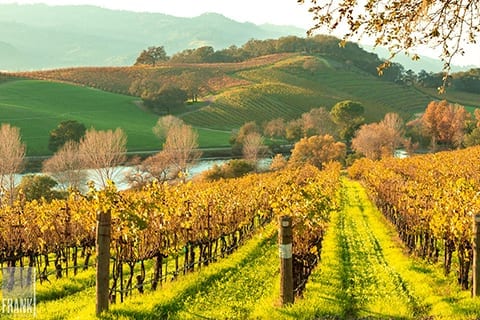 3. Vineyards and Landscapes Photography
3. Vineyards and Landscapes Photography
When shooting vineyards and landscapes, I follow similar principles to grape photography. These images are incredibly important to your customers who are looking at your website and other marketing materials. Plan your shoot for the morning or evening so you can catch the Sun as it rises or sets in the horizon. Think about the environment itself and use its natural features to benefit your pictures; morning fog can be a beautiful complement to the vineyard. I find that having a height advantage makes a big difference in a sweeping vineyard shot. If you have a pickup truck you can stand in the bed, or you can bring a 6-foot ladder to give you some extra height. Play with perspective and frame to change up your photo sets and get a selection of shots as attractive and diverse as the vineyard itself.
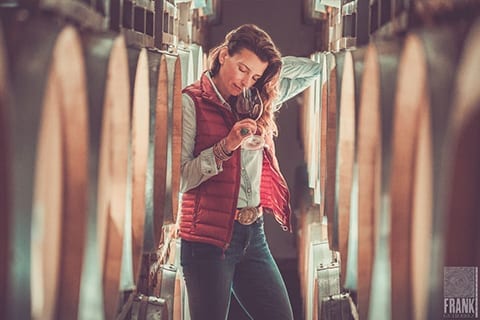 4. Portraits
4. Portraits
I love portrait photography. It’s an opportunity to tell your subject’s story while including your beautiful background as the setting. A portrait is more than just a headshot, and it can say so much if you take the time to select a nice location. If you’re shooting outside, plan your photo for the morning or evening light. A great, popular look is to have your subject backlit by the Sun. If you have to do your photoshoot outside in the middle of the day, look for a spot that’s covered in full shade so your subject’s face has nice even lighting. If you’re working indoors, try to bring your subject closer to natural ambient light from an open doorway or window.
Whether you’re working outside or inside, I highly recommend using an off-camera flash with a beauty dish or softbox. The off-camera flash will ensure your subject’s best features are captured and give you the ability to control the exposure of your background, to maximize where the focus of the image is.
Action shots are very engaging so I like to encourage my subjects to perform an action they’re familiar with. The resulting photo tends to look more candid and natural. Posing is important, and there are a few things you can do to create a more engaging photo. Start by leaning your forehead towards the lens and dropping your chin — often I’ll have to adjust this because most people will tend to lean in too far or lower their chin too much. Make slight adjustments until you find that ideal angle to result in the perfect portrait.
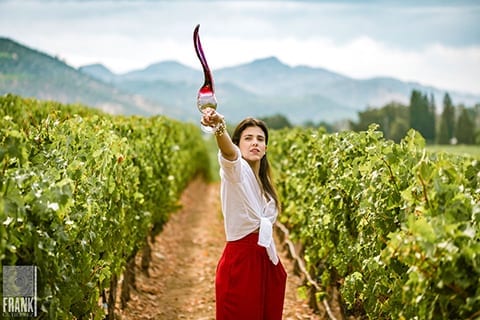 5. Hire a Professional
5. Hire a Professional
Working with a professional photographer will always be your best option when creating new and exciting content for your marketing campaign. Professional photographers like myself come equipped with various lenses, lighting equipment, and years of experience behind the camera. Our experience working with the best digital photo processing software ensures your final shots are always beautiful and at their best. I know that it can be challenging to communicate your marketing needs to a photographer, so I like to encourage my clients to pull reference images from the web and design a creative mood board to help both parties get insync.
Working together to make a photo set that proudly represents your brand should be the goal of every photographic partnership.
About the Author:
 Frank Gutierrez is a Napa Valley based commercial photographer with over 10 years experience working in the wine industry. His career in the creative world began in Hollywood, where he gained experience in the television commercial industry working alongside talented directors and producers. That exposure to professional artistry continues to suffuse all his work to this day and has afforded him multiple editorial and advertising publications in Wine Spectator Magazine. www.frank-gutierrez.com
Frank Gutierrez is a Napa Valley based commercial photographer with over 10 years experience working in the wine industry. His career in the creative world began in Hollywood, where he gained experience in the television commercial industry working alongside talented directors and producers. That exposure to professional artistry continues to suffuse all his work to this day and has afforded him multiple editorial and advertising publications in Wine Spectator Magazine. www.frank-gutierrez.com










